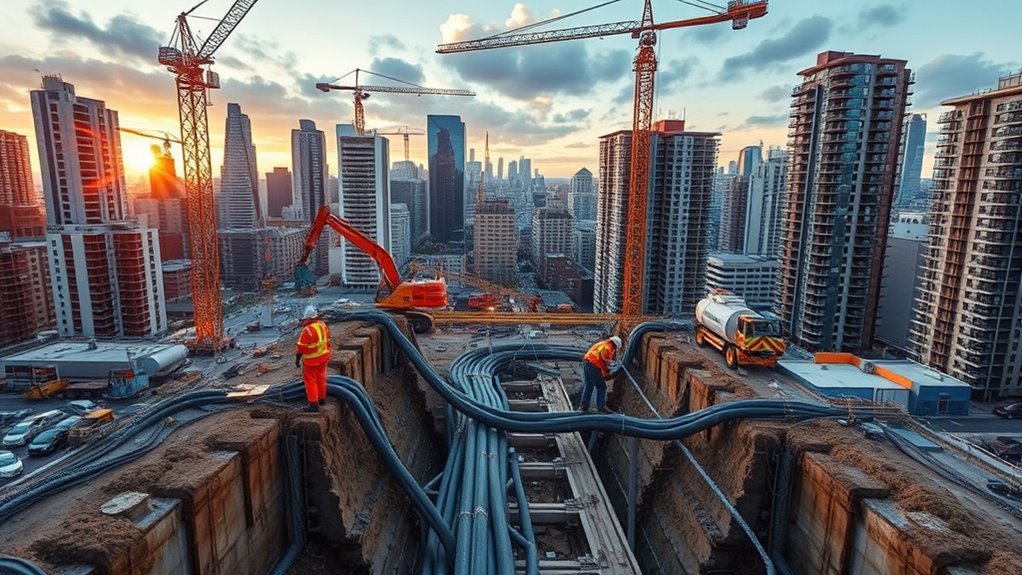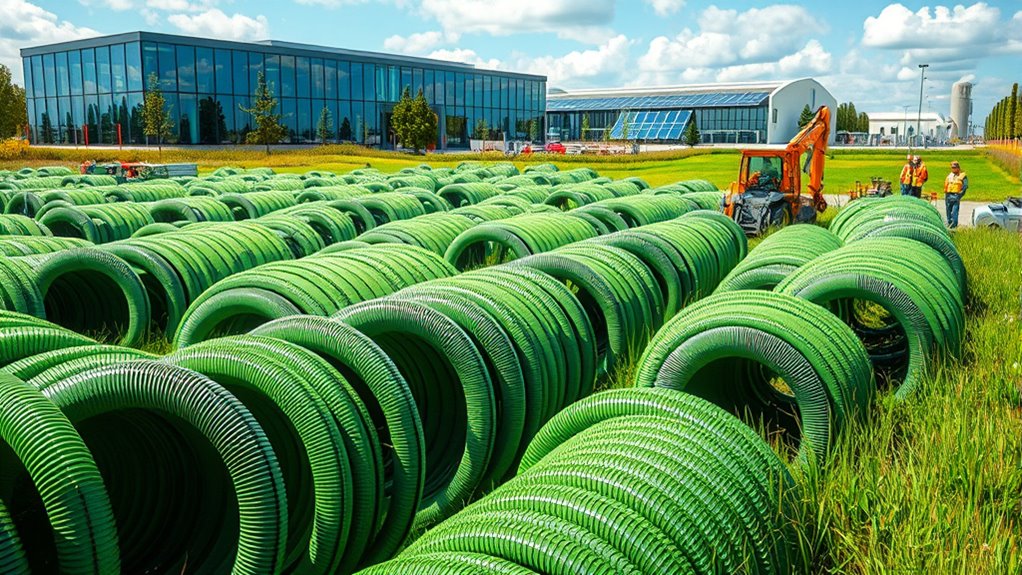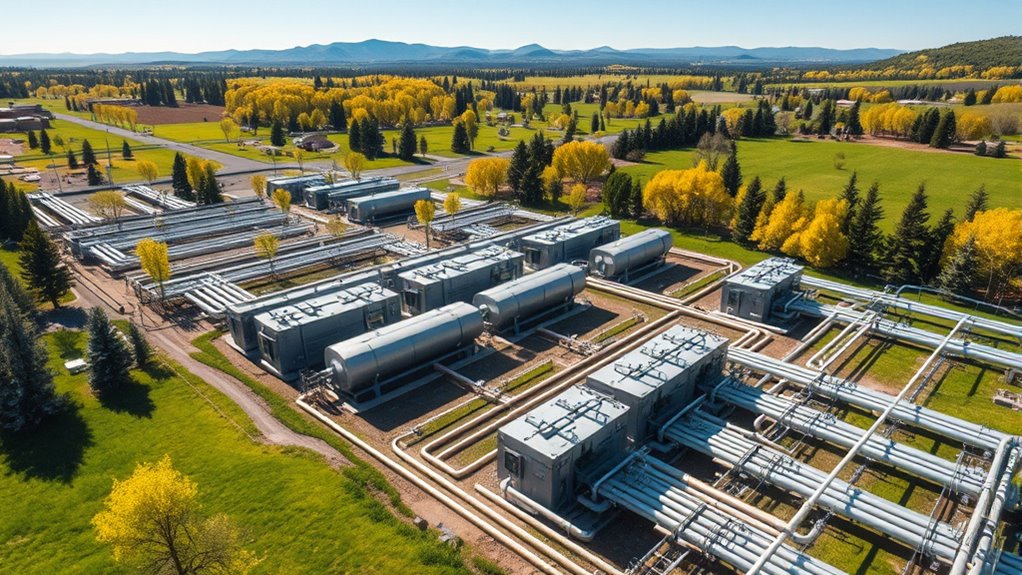Geothermal heat pumps are ideal for large-scale applications, offering reliable, efficient heating and cooling for big buildings and districts. They use underground loops that maintain stable temperatures, delivering high COPs and reducing energy costs. Urban systems and district energy loops maximize space and efficiency, integrating advanced components and innovative designs. With ongoing technological developments, these systems become easier to install and expand. If you want to explore how these innovations can benefit your projects, you’ll find valuable insights ahead.
Key Takeaways
- Large-scale geothermal heat pumps provide efficient, reliable heating and cooling for multiple buildings via district energy loops.
- Advanced components like tandem compressors and electronic expansion valves optimize performance and energy savings.
- Modular, compact designs and vertical boreholes enable installation in space-constrained urban environments.
- District energy systems distribute thermal energy underground, reducing infrastructure costs and improving resilience.
- Automation, robotics, and prefabricated modules are innovations that lower installation costs and accelerate deployment.
How Large Buildings Benefit From Geothermal Systems

Large buildings gain significant advantages from geothermal heat pumps because their extensive ground loop systems provide reliable, efficient heating and cooling. With geothermal, large buildings can tap into stable underground temperatures to maintain consistent indoor climates, reducing energy costs substantially. High-capacity geothermal systems, like the Nordic W Series, range from 12 to 81 tons, making them ideal for multi-zone environments in large facilities. These systems support simultaneous heating and cooling, boosting efficiency with COPs up to 8.2. Plus, geothermal systems offer long-term reliability and lower maintenance needs compared to traditional HVAC setups. Installing district energy loops further enhances thermal stability, cuts peak electrical demand, and aligns with sustainability goals for urban or institutional large buildings.
Components and Design of Commercial Geothermal Heat Pumps

Commercial geothermal heat pumps, such as the Nordic® W Series, incorporate advanced components that guarantee efficient and reliable operation. Their design includes tandem Bitzer scroll compressors with staging capabilities and electronic expansion valves, ensuring precise control and energy efficiency. These units feature a stainless steel water circuit suitable for open or closed loop systems, supporting capacities from 12 to 81 tons with high-temperature options. To enhance reliability, they include full-phase protection, suction line accumulators, sight glasses, and digital onboard aquastats for easy monitoring. The integrated smart controls enable optimal system performance and diagnostics, further improving operational efficiency. These controls utilize advanced data processing to optimize performance in real-time. The compact design with reinforced, industrial-strength frames allows flexible installation in tight spaces, either side-by-side or vertically. Additionally, advanced control interfaces like BACnet, USB ports, and user-friendly displays facilitate system management and seamless integration into building automation systems. Efficient operation is further supported by the integration of smart controls and high-quality components, ensuring long-term performance. Moreover, the use of reliable components minimizes downtime and maintenance costs over the lifespan of the system. Incorporating zoning capabilities in design can also improve energy distribution and overall system efficiency.
Advantages of the Nordic® W Series for Urban Scale Projects

The Nordic® W Series offers several advantages that make it ideal for urban-scale projects. Its high capacities, from 12 to 81 tons, meet the demands of large-scale geothermal heat pump systems. The compact footprints, such as 25” x 49” and 29” x 60”, allow seamless installation in tight city spaces. Easy access for installation and maintenance, along with side-by-side stacking, maximizes limited urban areas. The system’s tandem Bitzer scroll compressors with staging and electronic expansion valves deliver precise control and efficiency. Its high COP of up to 4.1 ensures energy-efficient operation. This combination of power, compactness, and adaptability makes the Nordic® W Series a smart choice for complex urban geothermal heat pump applications. innovative design ideas can further optimize space and performance in urban settings. Incorporating energy-efficient components enhances the overall sustainability and operational cost savings of these systems. Additionally, the use of sustainable technologies aligns with increasing environmental standards and urban planning requirements. Embracing modern engineering solutions can also contribute to better integration with existing infrastructure, further benefiting urban projects. Moreover, integrating advanced control systems can improve system responsiveness and optimize energy use in dynamic urban environments.
Implementing District Energy Loops for Greater Efficiency

Implementing district energy loops improves how you distribute thermal energy across multiple buildings, making the system more efficient. By sharing a common underground water network, you can cut infrastructure costs and reduce the need for separate HVAC setups. This approach not only boosts energy savings but also enhances system resilience and scalability for future growth.
Enhanced Energy Distribution
District energy loops markedly boost geothermal system efficiency by enabling the transfer of thermal energy across multiple buildings through extensive underground piping. With district energy, you create a centralized network that acts as a thermal reservoir, providing stable heating and cooling by balancing heat exchange throughout the connected infrastructure. This setup reduces the size and operational costs of individual geothermal systems, making large-scale applications more economical. By reclaiming and reusing waste heat within the district energy network, you increase the effective COP, further enhancing overall efficiency. Additionally, these loops improve system resilience, protecting assets from weather disruptions and vandalism while maintaining consistent performance. Incorporating dog names that reflect the personality of the system could also enhance user engagement. Implementing underground geothermal district loops not only streamlines energy distribution but also delivers significant savings and sustainability benefits.
Reduced Infrastructure Costs
By using extensive underground piping systems to serve multiple large buildings, district energy loops substantially cut down on individual installation costs compared to installing separate systems for each structure. This shared approach leverages geothermal energy efficiently, reducing the need for multiple heat pumps and related infrastructure. Implementing a centralized geothermal loop allows for simultaneous heating and cooling across zones, further decreasing equipment expenses. Additionally, large-scale geothermal district systems benefit from existing subsurface data and automation, which speeds up drilling and lowers overall project costs. Using centralized loops also minimizes land disturbance and material use, resulting in lower initial capital and ongoing maintenance expenses. Ensuring optimal soil conditions can significantly enhance the efficiency and longevity of geothermal systems. Furthermore, integrating sustainable energy sources into district systems supports long-term environmental goals. Incorporating proper system design principles ensures reliable performance and maximizes energy savings. For large commercial applications, scaling geothermal district loops makes geothermal energy deployment more cost-effective and sustainable.
Overcoming Installation Challenges in Dense Environments

Installing geothermal heat pumps in dense urban environments presents significant challenges due to limited land availability and complex geology. To navigate these constraints, you need innovative solutions that maximize space. Compact, modular heat pump designs and vertical borehole configurations help make efficient use of restricted areas, maintaining system capacity without requiring large land footprints. Traditional drilling can be slow and costly, especially in areas with complex geology or limited access. To address this, advancements in software, automation, and robotic drilling are being developed, reducing drilling time and increasing accuracy in tight spaces. Proper site assessment and innovative layout planning are essential to overcoming space limitations, ensuring reliable, scalable geothermal systems that fit within dense environments while delivering ideal performance. Additionally, utilizing specialized drilling equipment designed for challenging conditions can further optimize installation efficiency. Incorporating advanced planning tools can also assist in designing optimal layouts that maximize space utilization and system performance. Moreover, ongoing research into geothermal system integration offers potential for even more streamlined installation processes in urban settings. Recognizing the importance of sustainable infrastructure, developers are increasingly adopting these innovative approaches to promote environmental benefits and energy efficiency in crowded areas. Embracing innovative drilling technologies can significantly reduce the environmental impact of installation projects, contributing to more sustainable urban development.
Innovations in Drilling and System Scaling Technologies

Recent advancements in drilling technology and system design are transforming geothermal projects, especially in space-constrained urban environments. Robotics, automation, and subsurface sensors now enable faster, more precise drilling, reducing costs and installation times. Real-time data analytics help adapt to geological variability, minimizing risks and improving borehole accuracy. Additionally, innovations in geothermal system scaling are enabling the development of compact, high-capacity geothermal systems to fit within limited urban spaces, increasing scalability with more boreholes and piping. These innovations also benefit from risk mitigation strategies, which enhance project reliability and investor confidence. Modular heat pumps and pre-fabricated components allow for quicker deployment and easier expansion, making large-scale projects more feasible. These innovations reduce the physical and financial footprint of geothermal systems, broadening accessibility for commercial and industrial applications.
Comparing Geothermal and Traditional HVAC for Big Buildings

When comparing geothermal and traditional HVAC systems for large buildings, efficiency is a key factor to contemplate. Geothermal heat pumps provide consistent heating and cooling with lower operational costs, even in extreme weather. However, initial installation costs and complexities can pose challenges that you’ll want to weigh carefully. Incorporating sound design principles can also enhance the acoustic environment within HVAC systems, improving occupant comfort and communication. Additionally, understanding potential allergy risks related to installation processes or system components can be important for maintaining a healthy indoor environment. Considering insurer ratings can help ensure that your investment in geothermal systems is protected and supported over the long term. Proper system maintenance is essential to prevent issues like corrosion or mineral buildup, which can compromise performance and lifespan. Evaluating the nutritional advantages of green juice may seem unrelated but highlights the importance of thorough analysis when choosing sustainable solutions, as well as the need for proper system maintenance to maximize benefits.
Efficiency in Large Spaces
In large buildings, geothermal heat pumps outperform traditional HVAC systems by maintaining consistently high efficiency regardless of outdoor conditions. They achieve a coefficient of performance (COP) of up to 4.1, moving over four units of heat per unit of electricity, which surpasses conventional systems. Advanced geothermal setups support simultaneous heating and cooling with dual heat pumps and buffer tanks, doubling their COP to over 8.2 in large-scale applications. Because underground temperatures stay stable year-round, geothermal heat pumps retain high efficiency even during extreme weather, unlike traditional HVAC systems that struggle in such conditions. Their modular, space-saving design allows scalable installation, reducing operational costs. Additionally, filtration system components in geothermal systems help improve indoor air quality by reducing airborne contaminants. Ensuring proper system maintenance is essential for maintaining peak performance and longevity of geothermal installations. Overall, geothermal systems deliver superior efficiency, especially in large spaces requiring continuous, reliable climate control.
Cost and Installation Challenges
Although geothermal heat pumps offer long-term savings through higher efficiency, their initial installation costs are considerably higher than those of traditional HVAC systems. The main factor driving these initial costs is the installation process, which involves drilling boreholes and laying underground loops. This requires specialized equipment and expertise, especially in challenging geological conditions, increasing the overall installation expenses. In contrast, traditional HVAC systems have lower initial costs because they require simpler equipment and no extensive underground infrastructure. Additionally, geothermal installation can be complex, with longer project timelines and higher labor costs, particularly in urban or constrained sites. While the operational savings are attractive, the significant upfront investment remains a key challenge when comparing geothermal systems to traditional HVAC solutions for large buildings.
Enhancing Sustainability and Reducing Operating Costs

Enhancing sustainability and reducing operating costs with geothermal heat pumps is highly effective due to their high efficiency and reliable performance. By harnessing renewable energy from the earth, these systems considerably lower energy consumption, directly decreasing operating costs. With a coefficient of performance (COP) of 4.1, they move more heat per unit of electricity, saving money on energy bills. When equipped with buffer tanks and multiple heat pumps for simultaneous heating and cooling, efficiency can double to a COP of 8.2, further cutting expenses. Underground ground loops provide long-lasting thermal stability, minimizing maintenance costs over decades. Additionally, geothermal district energy loops enable multiple buildings to share infrastructure, optimizing energy use and reducing overall operational expenses.
Case Studies of Successful Large-Scale Geothermal Projects

You’ll see how large-scale geothermal projects are making an impact across different regions and sectors. These systems are designed to maximize efficiency and cost savings, proving their value in diverse settings. Exploring these successful case studies highlights the extensive potential of geothermal heat pumps for sustainable infrastructure.
Diverse Regional Deployments
Diverse regional conditions have demonstrated the versatility and success of large-scale geothermal heat pump projects across the United States. From Alaska to Texas, these projects showcase how geothermal heat pump systems adapt to different geology, climate, and operational needs. Colorado Mesa University operates one of North America’s largest geothermal district energy loops, saving over $500,000 annually. The Marine Corps Logistics Base in Georgia uses geothermal heat pumps for climate control, highlighting military and government adoption. Additionally, the Dallas-Fort Worth bridge de-icing system employs geothermal technology for sustainable winter maintenance. These examples prove that large-scale applications of geothermal heat pumps can thrive in varied regional settings, delivering reliable, cost-effective heating and cooling solutions regardless of climate or geological differences.
Large-Scale System Designs
Large-scale geothermal systems demonstrate the impressive potential of district energy solutions when designed for extensive operations. These system designs efficiently serve multiple buildings, as seen at Colorado Mesa University, where 3 miles of underground piping support 16 structures, saving over $500,000 annually. North Carolina State University’s large-scale district loop with micro loops ensures zone-specific control, keeping power demand below 4 MW despite campus growth. At Denver International Airport, a geothermal district system recycles waste heat, reducing reliance on traditional HVAC and increasing resilience. The Marine Corps Logistics Base in Georgia employs interconnected large-scale heat pump units for reliable heating and cooling across vast facilities. Successful large-scale system designs enhance efficiency, with some achieving COP values over 8 through simultaneous heating and cooling, proving geothermal’s capability for extensive applications.
Cost and Efficiency Benefits
Successful large-scale geothermal projects demonstrate significant cost savings and high efficiency, making them a compelling choice for extensive energy needs. For example, the Colorado Mesa University system saves over $500,000 annually and reduces water use by 14 million gallons. You’ll also benefit from high efficiency, like the Nordic W Series heat pumps with a COP of 4.1, with some systems reaching a combined COP of 8.2 for heating and cooling. Additionally, properly designed systems lower ongoing operational and maintenance costs compared to traditional HVAC. Innovations such as advanced automation, robotics, and subsurface data integration further decrease installation costs and time, enhancing economic viability. These case studies clearly show that geothermal’s cost and efficiency advantages make it a smart investment for large-scale applications.
Future Trends in Geothermal Technology for Commercial Use

Advancements in software, automation, and robotics are substantially lowering installation costs and time, making large-scale geothermal systems more practical for commercial buildings. With these innovations, installing geothermal heat pumps and commercial heat pumps becomes faster and more affordable. Compact, efficient borehole drilling technologies allow you to install extensive underground loops even in limited urban spaces. Modular and scalable system designs enable you to expand your geothermal solutions with minimal land use and simplified construction. Improved subsurface data and sensors enhance drilling accuracy, reducing geological risks and overall project costs. These developments support the growth of high-capacity, multi-unit geothermal solutions, facilitating the expansion of district energy loops. This trend promises a more efficient, scalable future for commercial geothermal applications.
Frequently Asked Questions
How Big of a Yard Do You Need for a Geothermal Heat Pump?
You might wonder how much yard space you’ll need for a geothermal heat pump. The size depends on your system type and land availability. Vertical loops require as little as 150-300 square feet per borehole, perfect for small areas. Horizontal loops need several acres, especially for large systems. Factors like soil, climate, and system capacity influence the size, so a thorough site assessment helps determine the ideal space for your installation.
What Is the Downside of Geothermal Heating?
The downside of geothermal heating is primarily its high upfront costs, which include drilling and site prep. You might also face design complexities that risk inefficiency or increased maintenance. Geographic and land space limitations can make installation tough, especially in urban areas. Plus, the long payback period—often 5 to 15 years—can deter you from investing, despite the potential for long-term savings.
How Much Does It Cost to Put Geothermal in a 2000 Sq Ft House?
You’re probably wondering about the cost to install a geothermal system in your 2,000 sq ft house. Typically, it ranges from $20,000 to $40,000, depending on soil conditions and system complexity. Vertical loops usually cost more than horizontal. Keep in mind, incentives like tax credits can cut your costs by nearly a third. Over time, you’ll save 30-60% on energy bills, making it a smart investment.
What Is the Large Scale Thermal Program?
You might find it surprising that large-scale thermal programs can cut energy costs by up to 50%. These initiatives deploy geothermal heat pump systems across multiple buildings or entire campuses, using underground loops to provide efficient heating and cooling. You benefit from reduced carbon emissions, improved energy resilience, and lower utility bills. By integrating innovative design and automation, these programs support regional decarbonization and optimize energy management for dense urban areas.
Conclusion
Harnessing geothermal energy for large-scale buildings isn’t just a smart choice—it’s a powerful step toward a sustainable future. As you embrace this technology, imagine the legacy you leave: a greener planet, lower costs, and a beacon of innovation. Don’t let the opportunity slip away like passing seasons. Instead, seize it today, and watch your efforts blossom into a lasting impact that echoes through generations, proving that true progress begins with bold, decisive action.









